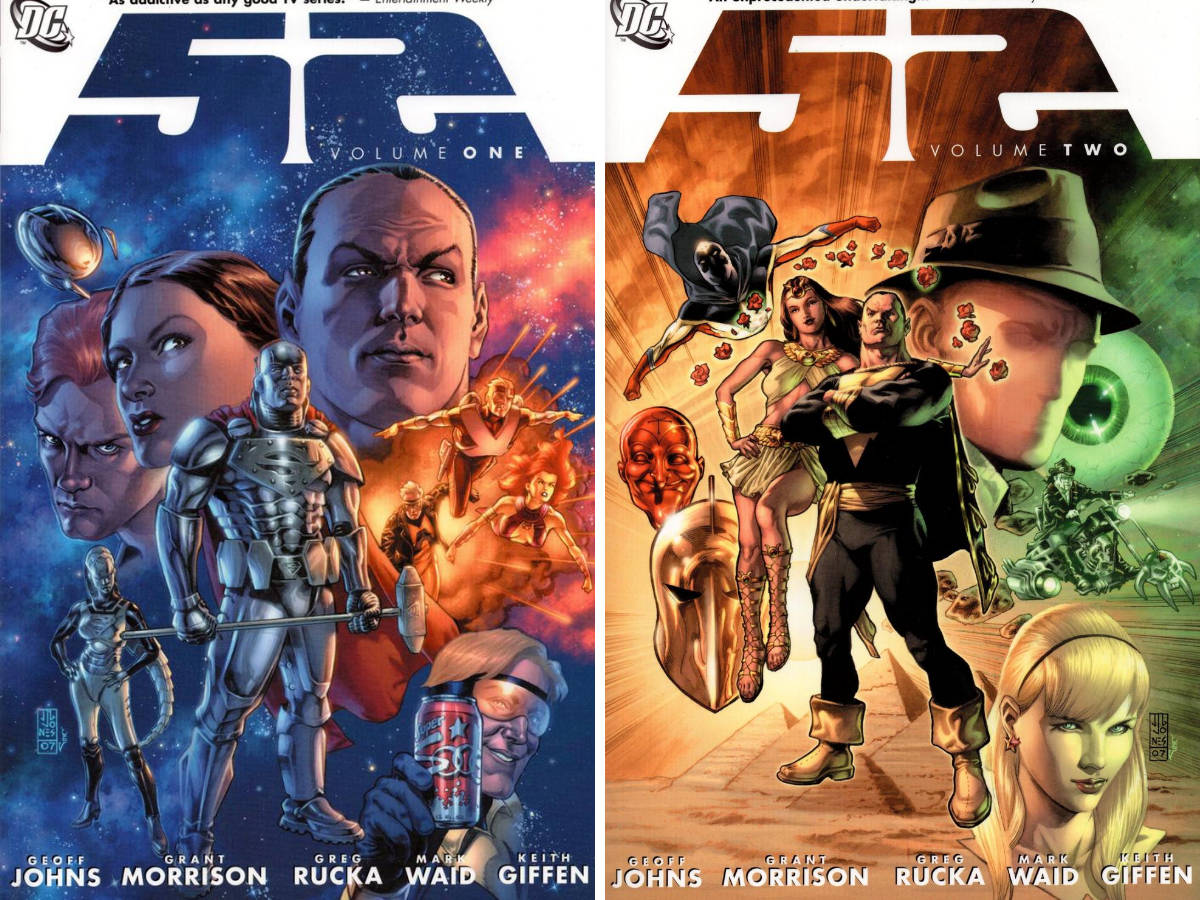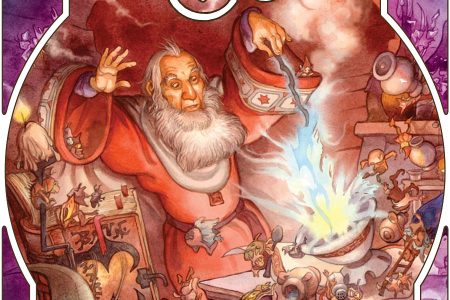[I’m so inconsistent: I was doing well, with regular posting and reviewing, then I miss a day and I go AWOL. Then Christmas comes along and everything goes to pot. I was meaning to post over Christmas, but that was a little ambitious. So, let’s try to get things back on track and lead up to one of those ‘my favourite comic books’ posts that are so popular these days.]
52 (issues #1–52, collected in four trade paperbacks) written by Grant Morrison, Mark Waid, Greg Rucka, Geoff Johns; breakdowns by Keith Giffen; art by various.
I’m not a DC universe guy – I grew up reading Marvel and the X-Men – so I wasn’t going to buy fifty-two comic books about the back waters of the Distinguished Competition. However, I wanted to read the series because of its singular achievement: a weekly full-colour comic book written by four writers over the course of a year, never missing an issue, and telling multiple stories with a consistent tone.
The books themselves are a great package, containing the comics and the excellent covers from JG Jones (although unfortunately in small size only; this is one of the few times a book collecting the covers is actually justified) as well as commentary from the main people involved (with the exception of Grant Morrison) and some breakdowns/pencils by Giffen.
There are different storylines to follow in 52: Ralph Dibny investigating; Renee Montoya being tested by The Question; Steel, Natasha and Lex Luthor and the metagene; Booster Gold being a hero with the aid of Skeets; Black Adam and Khandaq. Obviously, with so many different angles, there is a lot going on: there’s the cult of Superboy, Black Adam ripping a criminal in half (nice, DC), we see superhero ‘ER’ with Dr Midnite, Space Heroes (Animal Man, Adam Strange and Starfire) stranded, the advent of the Chinese superheroes – The Great Ten (with great names and powers – must have been Grant), Rip Hunter saying ‘Time is broken’, the introduction of Batwoman, Luthor’s Everyman project, the arrival of a new superhero (Supernova) in Metropolis, Black Adam creating a new Marvel (Isis) – and this is just in the first trade.
There is also a lot of time for nice character moments, such as Clark being fired for not being good enough to be a reporter without his powers (and the nice scene between Clark and Lois afterwards), or the interplay between Montoya and her former lover Kate Kane, or the state of Ralph’s mind in his quest. This is one of the positive aspects of doing 52 issues – there is a lot of time to delve into the players in the story, not just 22 pages each week of action. There is still four-colour entertainment the way you like it, but the writers have definite plans for the characters and showing this via the story.
 Booster Gold dies saving Metropolis from a nuclear submarine (to the shock of Skeets), Black Adam and Isis marry, Lobo helps the Space Heroes (under a vow of non-violence), Ralph is called in to solve a locked-room mystery (the Helmet of Fate has killed Tim Trench in the House of Mystery), Will Magnus is captured by his Metal Men and taken to Oolong Island where all the other missing mad scientists are (which is an absolute genius idea – step forward, Grant Morrison), Black Adam makes Isis’ brother into another Marvel (Osiris) – there is a nice joke about the Question saying the Marvel names to see if it’s contagious. There is the ‘new’ Justice League: Firestorm, Bulleteer, Super Chief (a native American superhero), Firehawk and … Ambush Bug! (‘Hello, Room Service? Send up a plot and three pages of dialogue right away! The weekly grind is tearing me apart! Fifty-two!’). There is there return of Amanda ‘The Wall’ Waller and Checkmate and the Suicide Squad. Again, this is only halfway through the series.
Booster Gold dies saving Metropolis from a nuclear submarine (to the shock of Skeets), Black Adam and Isis marry, Lobo helps the Space Heroes (under a vow of non-violence), Ralph is called in to solve a locked-room mystery (the Helmet of Fate has killed Tim Trench in the House of Mystery), Will Magnus is captured by his Metal Men and taken to Oolong Island where all the other missing mad scientists are (which is an absolute genius idea – step forward, Grant Morrison), Black Adam makes Isis’ brother into another Marvel (Osiris) – there is a nice joke about the Question saying the Marvel names to see if it’s contagious. There is the ‘new’ Justice League: Firestorm, Bulleteer, Super Chief (a native American superhero), Firehawk and … Ambush Bug! (‘Hello, Room Service? Send up a plot and three pages of dialogue right away! The weekly grind is tearing me apart! Fifty-two!’). There is there return of Amanda ‘The Wall’ Waller and Checkmate and the Suicide Squad. Again, this is only halfway through the series.
To keep the schedule of a weekly comic book, there are lots of artists. This is means there is an unevenness to the art – Joe Bennet does a lot of work as does Chris Batista, with the likes of Ken Lashley, Eddy Barrows, Todd Nauck, Patrick Oliffe doing issues. There are some nice issues by Dale Eaglesham, Phil Jiminez, Drew Johnson and Darick Robertson, which highlight the difference between all the art, but it would be impossible to have only a few artists being able to hit all the deadlines, especially some of the bigger names, so this can be excused for the enormity of the task.
The scope of the book covers all the aspects of DC universe that I’ve come across – from space to the various aspects on Earth (the street level, the science heroes, the magic, the villains, the non-powered heroes), 52 demonstrates the wondrous expanse of the DC universe and what it has to offer. The writers took hold of the opportunity to show you why they love the DC comic books so much, and they’ve done an admirable job of doing it in an entertaining fashion. There are great twists and turns (the reveal of Supernova and Skeets, the Space Heroes saved by Lantern Mogo [the planet Green Lantern], the reveal of Sobek) and there is one of my favourite moments in comic books – when Ralph, in the Tower of Fate, he shoots the Helmet of Fate he is wearing with the wedding ring to reveal it was Felix Faust: ‘You knew it was me …? How?’ ‘Because Faust … I’m a detective.’ He then explains everything and even gets Neron trapped into the bargain – even in death he’s better than them as the spell of binding keeps Neron and Faust in. Absolutely brilliant. Even the mad scientists have their day, as they take down Black Adam after he has destroyed Bialya (and everyone in it) in his grief: ‘Feel free to cackle hysterically gentleman.’ I love the humour of the book in places, such as the best line in the book for Will Magnus: ‘I have a particle wave ray gun and bipolar disorder. I have no idea what I might do if I pull the trigger.’
Is 52 perfect? No (even Rucka notes in the commentary that he isn’t happy with the solution to the Wonder Woman) and there is a level of death, gore and violence that jars with the spirit of nobility that pervades the book. Some characters aren’t given enough screen time, and the end of the series veers away from the rest of the book (with the universe-eating villain and the saving of 52 worlds). However, in total, this is a book unlike any other, an exciting and absorbing tour of a universe of characters and heroes and imagination that leaves you with a big smile on your face with the ending for the Dibnys as they become Ghost Detectives. This collection of the comics is an amazing undertaking and an incredible achievement and made me do something I hardly do: after reading them from the library, I had to buy the trades for myself. That’s a good recommendation.




